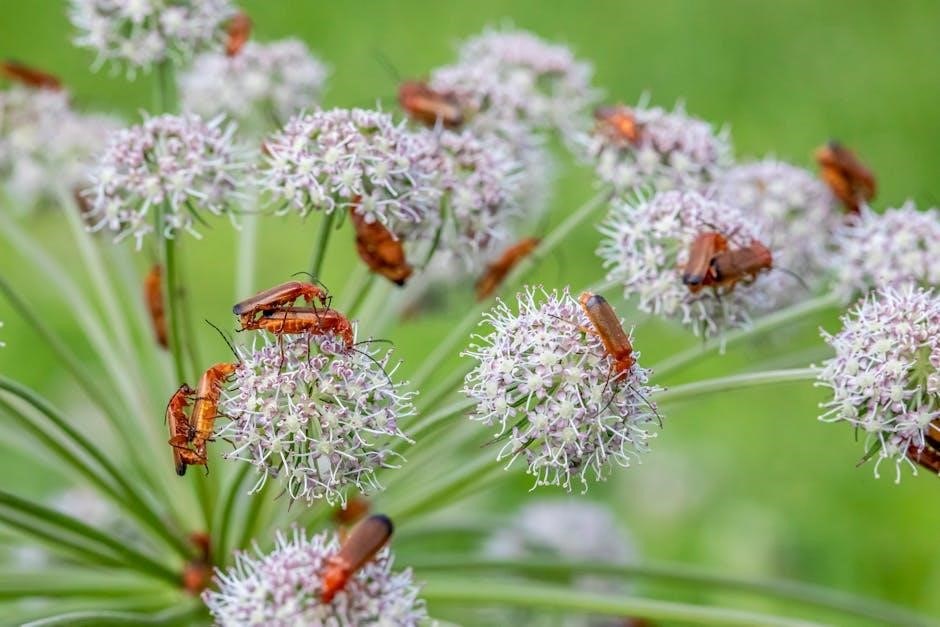Parts of a Flower Worksheet PDF: A Comprehensive Guide
Discover engaging flower anatomy worksheets for kids! Our guide offers printable PDFs, diagrams, labeling activities, and even a fun flower craft to explore the parts of a flower.
Flower anatomy worksheets are a fantastic educational tool for introducing children to the fascinating world of botany. These worksheets provide a hands-on approach to learning about the different parts of a flower and their functions. From the brightly colored petals that attract pollinators to the essential reproductive structures like the stamen and pistil, flower anatomy worksheets offer a visual and interactive way for kids to grasp these concepts. Many worksheets include diagrams that kids can label, cut-and-paste activities, and crossword puzzles that reinforce their understanding. They often cover key vocabulary such as anther, filament, stigma, style, ovary, and ovule. Some worksheets also incorporate creative elements like coloring and drawing, making the learning process more enjoyable. By exploring these worksheets, children can develop a deeper appreciation for the complexity and beauty of flowers, while also building a solid foundation in basic biology. Whether used in the classroom or at home, flower anatomy worksheets are an excellent resource for budding botanists and curious minds. They are designed to cater to various grade levels, ensuring that the content is both engaging and age-appropriate. With free printable options readily available, these worksheets make learning about flower anatomy accessible to all.

Understanding the Key Parts of a Flower

Flowers are vital for plant reproduction. Key parts include the stamen (male) with anther and filament, and the pistil/carpel (female) with stigma, style, and ovary. Petals attract pollinators.
Stamen: The Male Reproductive Part
The stamen is the male reproductive organ of a flower, playing a crucial role in plant propagation. It consists of two main parts: the filament and the anther. The filament is a slender, stalk-like structure that supports the anther. Its primary function is to elevate the anther, positioning it in a way that facilitates pollen dispersal. The anther, located at the tip of the filament, is responsible for producing pollen grains. Pollen grains contain the male genetic material necessary for fertilization.
The anther typically consists of two lobes, each containing pollen sacs where pollen develops. Inside these sacs, specialized cells undergo meiosis, a type of cell division that reduces the number of chromosomes by half, resulting in the formation of haploid pollen grains. These pollen grains are eventually released from the anther and can be transferred to the female reproductive part of the flower, the pistil, through various means such as wind, water, or animal pollinators.
The structure and arrangement of the stamen can vary significantly among different plant species. Some flowers may have numerous stamens, while others may have only a few. The length of the filament and the size and shape of the anther can also differ depending on the plant species and its pollination strategy. In some cases, the stamens may be fused together or to other floral parts, forming complex structures that enhance pollination efficiency. Understanding the structure and function of the stamen is essential for comprehending the reproductive biology of flowering plants.
Pistil/Carpel: The Female Reproductive Part
The pistil, also known as the carpel, is the female reproductive organ of a flower, essential for seed production. It’s composed of three main parts: the stigma, style, and ovary. The stigma, located at the uppermost part of the pistil, serves as the receptive surface for pollen grains. Its often sticky or feathery texture helps to capture pollen effectively. The style is a slender, stalk-like structure connecting the stigma to the ovary. It acts as a pathway for pollen tubes to grow from the stigma down to the ovary, facilitating fertilization.
The ovary, situated at the base of the pistil, contains one or more ovules. Each ovule encloses an egg cell, which, upon fertilization by a sperm cell from a pollen grain, develops into a seed. The ovary itself matures into a fruit, which serves to protect and disperse the seeds. The number of carpels in a flower can vary, with some flowers having a single carpel and others having multiple carpels that may be fused together or remain separate.
The structure of the pistil is crucial for successful pollination and fertilization. The stigma’s ability to capture pollen, the style’s role in guiding pollen tubes, and the ovary’s capacity to nurture developing seeds all contribute to the reproductive success of flowering plants. Variations in pistil morphology among different plant species reflect adaptations to different pollination strategies and environmental conditions. Studying the pistil provides valuable insights into the intricate processes of plant reproduction and evolution. The pistil is a vital component of the flower, enabling the creation of new generations of plants.

Worksheet Activities: Labeling and Identification
Enhance learning with our flower worksheet activities! Practice identifying and labeling flower parts using diagrams, cut-and-paste exercises, and crossword puzzles. Perfect for hands-on learning!
Cut-and-Paste Labeling Activities
Engage children with interactive cut-and-paste labeling activities focused on flower anatomy! These worksheets feature diagrams of flowers with labeled lines pointing to different parts, such as petals, sepals, stamens, pistils (including stigma, style, and ovary), filaments, and anthers. Kids cut out labels with the names of each part and paste them onto the corresponding lines on the flower diagram. This hands-on approach reinforces visual recognition and vocabulary acquisition, making learning about flower parts fun and memorable.
These activities are designed to cater to different learning styles. The act of cutting and pasting enhances fine motor skills while associating the written word with the visual representation of each flower part strengthens memory retention. Furthermore, these worksheets can be adapted for various age groups and skill levels. Simpler versions might focus on labeling only the primary parts like petals, stem, leaves, and roots, while more advanced versions can incorporate the reproductive structures in detail.
To extend the learning experience, consider pairing these cut-and-paste activities with real flower dissections. After completing the worksheet, children can carefully dissect a flower, identify the parts they labeled, and compare their findings to the diagram. This provides a tangible connection to the science concept and fosters deeper understanding. These activities are a great way to introduce botany and plant biology to young learners in a creative and engaging way, nurturing their curiosity about the natural world.
Crossword Puzzle Worksheets
Introduce a fun and challenging way to learn about flower parts with crossword puzzle worksheets! These engaging puzzles use clues related to the anatomy and function of different flower components, such as the stamen, pistil, petals, sepals, anther, filament, stigma, style, and ovary. Students solve the crossword by filling in the blanks with the correct terms, reinforcing their understanding of flower vocabulary in an entertaining format.
Crossword puzzles offer several educational benefits. They improve vocabulary skills, enhance critical thinking, and encourage problem-solving abilities. By deciphering the clues and fitting the correct words into the grid, students actively engage with the material and solidify their knowledge of flower anatomy; These worksheets can be used as a review activity, a homework assignment, or a fun classroom exercise.
To make the activity more interactive, consider incorporating visual aids. The crossword clues can be accompanied by images of different flower parts, helping students connect the terms with their visual representations. Additionally, you can challenge students to create their own crossword puzzles based on flower anatomy, encouraging them to delve deeper into the subject matter and demonstrate their understanding in a creative way. These crossword puzzle worksheets offer a stimulating and effective method for learning about the intricate world of flowers, suitable for various grade levels and learning environments, promoting both enjoyment and academic success.

Educational Resources and Printable PDFs
Access a variety of educational resources and printable PDFs to enhance learning about flower parts. Find worksheets suitable for different grade levels, including free options for kids and targeted materials for grades 4-6.
Free Printable Worksheets for Kids
Explore our collection of free printable worksheets designed specifically for kids to learn about the fascinating world of flower parts! These worksheets offer a fun and interactive way for children to identify and understand the different components of a flower, from the petals to the roots. Engage young learners with colorful diagrams and simple labeling activities that make learning about botany enjoyable. Discover worksheets that include cut-and-paste exercises where kids can assemble their own flower models, reinforcing their understanding of each part’s position and function. Spark curiosity with crossword puzzles featuring flower-related vocabulary, making learning a game! These free resources provide a foundation for understanding plant anatomy, perfect for introducing young minds to the wonders of the natural world. Our printable flower worksheets are ideal for kindergarten and early elementary students, providing an accessible and engaging introduction to the parts of a flower. Download and print these resources to support your child’s learning journey and cultivate a love for science and nature. Enhance your lesson plans with our free, easily accessible materials that make learning about flowers a blooming success! Make science education easy and fun with these valuable resources.
Worksheets for Grades 4-6
Elevate your science curriculum with our comprehensive collection of flower anatomy worksheets specifically designed for students in grades 4-6! These worksheets provide a deeper dive into the structure and function of flower parts, moving beyond basic identification to explore more complex concepts like pollination and reproduction. Engage students with detailed diagrams that illustrate the intricate relationships between the stamen, pistil, petals, and other essential components. Challenge students with matching exercises that connect flower parts to their specific roles in the plant’s life cycle, fostering a deeper understanding of their interdependence. Promote critical thinking with worksheets that ask students to describe how each flower part contributes to the pollination process, encouraging them to analyze and synthesize information. Explore interactive activities such as crossword puzzles and labeling exercises that reinforce vocabulary and solidify understanding of flower anatomy. Enhance learning with worksheets that delve into the differences between various flower types, encouraging students to observe and compare their unique characteristics. Our resources include answer keys for easy grading and assessment, making lesson planning simple and efficient; Spark curiosity and inspire a love for botany with these engaging and informative worksheets. Make science education both effective and enjoyable with these valuable tools.
